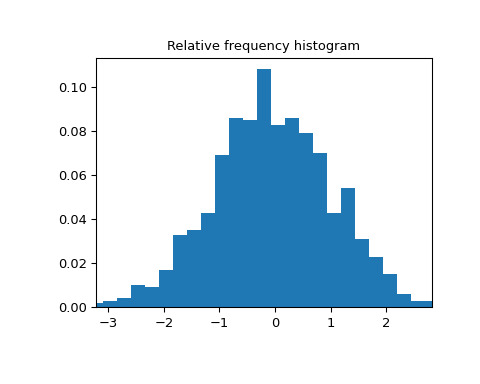本文简要介绍 python 语言中 scipy.stats.relfreq 的用法。
用法:
scipy.stats.relfreq(a, numbins=10, defaultreallimits=None, weights=None)#使用 histogram 函数返回相对频率直方图。
相对频率直方图是每个 bin 中的观察数量相对于观察总数的映射。
- a: array_like
输入数组。
- numbins: 整数,可选
用于直方图的 bin 数量。默认值为 10。
- defaultreallimits: 元组(下,上),可选
直方图范围的下限值和上限值。如果没有给出值,则使用比 a 中的值范围稍大的范围。特别是
(a.min() - s, a.max() + s),其中s = (1/2)(a.max() - a.min()) / (numbins - 1)。- weights: 数组,可选
a中每个值的权重。默认为无,它为每个值赋予 1.0 的权重
- frequency: ndarray
相对频率的分箱值。
- lowerlimit: 浮点数
实际下限。
- binsize: 浮点数
每个 bin 的宽度。
- extrapoints: int
加分。
参数 ::
返回 ::
例子:
>>> import numpy as np >>> import matplotlib.pyplot as plt >>> from scipy import stats >>> rng = np.random.default_rng() >>> a = np.array([2, 4, 1, 2, 3, 2]) >>> res = stats.relfreq(a, numbins=4) >>> res.frequency array([ 0.16666667, 0.5 , 0.16666667, 0.16666667]) >>> np.sum(res.frequency) # relative frequencies should add up to 1 1.0创建具有 1000 个随机值的正态分布
>>> samples = stats.norm.rvs(size=1000, random_state=rng)计算相对频率
>>> res = stats.relfreq(samples, numbins=25)计算 x 的值空间
>>> x = res.lowerlimit + np.linspace(0, res.binsize*res.frequency.size, ... res.frequency.size)绘制相对频率直方图
>>> fig = plt.figure(figsize=(5, 4)) >>> ax = fig.add_subplot(1, 1, 1) >>> ax.bar(x, res.frequency, width=res.binsize) >>> ax.set_title('Relative frequency histogram') >>> ax.set_xlim([x.min(), x.max()])>>> plt.show()
相关用法
- Python SciPy stats.rel_breitwigner用法及代码示例
- Python SciPy stats.recipinvgauss用法及代码示例
- Python SciPy stats.rayleigh用法及代码示例
- Python SciPy stats.rankdata用法及代码示例
- Python SciPy stats.rv_histogram用法及代码示例
- Python SciPy stats.random_table用法及代码示例
- Python SciPy stats.rvs_ratio_uniforms用法及代码示例
- Python SciPy stats.rice用法及代码示例
- Python SciPy stats.random_correlation用法及代码示例
- Python SciPy stats.ranksums用法及代码示例
- Python SciPy stats.rv_discrete用法及代码示例
- Python SciPy stats.randint用法及代码示例
- Python SciPy stats.rv_continuous用法及代码示例
- Python SciPy stats.rdist用法及代码示例
- Python SciPy stats.anderson用法及代码示例
- Python SciPy stats.iqr用法及代码示例
- Python SciPy stats.genpareto用法及代码示例
- Python SciPy stats.skewnorm用法及代码示例
- Python SciPy stats.cosine用法及代码示例
- Python SciPy stats.norminvgauss用法及代码示例
- Python SciPy stats.directional_stats用法及代码示例
- Python SciPy stats.invwishart用法及代码示例
- Python SciPy stats.bartlett用法及代码示例
- Python SciPy stats.levy_stable用法及代码示例
- Python SciPy stats.page_trend_test用法及代码示例
注:本文由纯净天空筛选整理自scipy.org大神的英文原创作品 scipy.stats.relfreq。非经特殊声明,原始代码版权归原作者所有,本译文未经允许或授权,请勿转载或复制。
